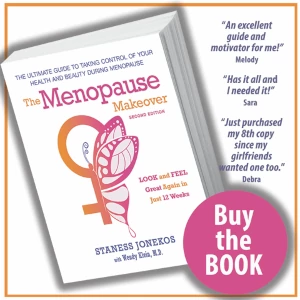 You’ve probably heard that moderate drinking is good for your heart. But you’ve probably also heard that it’s a danger for breast cancer and that it can trigger hot flashes. Here are the facts that can help you make decisions about drinking.
You’ve probably heard that moderate drinking is good for your heart. But you’ve probably also heard that it’s a danger for breast cancer and that it can trigger hot flashes. Here are the facts that can help you make decisions about drinking.
The most important thing is how much you drink. The benefits come with moderate—big emphasis on moderate—drinking. Starting with the Framingham Heart Study, big epidemiologic studies have shown that while moderate drinking has some benefits, drinking much more than that can be detrimental. More than two drinks per day and the negative effects begin to pile up, with increases in the rates of cancer, stroke, and more.
What’s One Drink?
This is how the National Institute on Alcohol Abuse and Alcoholism (NIAA) defines one standard drink:
- 5 fluid ounces (one glass) of wine (about 12% alcohol). Don’t let your wine glass fool you—most hold much more than 5 ounces.
- 12 fluid ounces (usually one can or bottle) of regular beer (about 5% alcohol)
- 1.5 fluid ounces (one shot) of 80-proof distilled spirits
This is how the NIAA defines different levels of drinking for women:
- Light: less than one drink per day
- Moderate: one to two drinks per day
- Heavy: more than two drinks per day
How Much Is Good?
- Light to moderate drinkers have a significantly lower risk of coronary heart disease than nondrinkers. For women, the heart benefits of moderate drinking become apparent at menopause when their heart disease risk normally goes up, and the heart benefits continue after that. Hormone therapy doesn’t affect that benefit.
- Women who drink moderately have a lower risk of type 2 diabetes.
- Those who drink moderate amounts of alcohol, especially wine, have a lower risk of dementia than those who don’t drink at all.
- Women who drink lightly or moderately have a lower risk of stroke than nondrinkers.
- At and after menopause (ages 50-62), women who drink moderately have stronger bones than nondrinkers.
- Midlife and older women who drink lightly or moderately have a lower risk of becoming obese than nondrinkers.
How Much Is Bad?
- Drinking may trigger hot flashes for some women, although that isn’t based in research. So determine whether it’s a personal trigger for you. (As for a general risk of experiencing hot flashes and night sweats, some studies find alcohol increases it, whereas others find the opposite.)
- Any amount of alcohol increases the risk of breast cancer. The increase in risk is there, but small, for women who drink one drink a day. Women who drink two to five drinks a day have about 1.5 times the risk of nondrinkers. (The increased risk doesn’t seem to have anything to do with alcohol’s effect on estrogen levels.)
- Drinking alcohol increases the risk of many other cancers. The risk rises with the amount of alcohol consumed. (And the risk rises higher if you smoke as well.)
- Alcohol has harmful interactions with many medications, even ones you may not think about, such as medicines for arthritis, indigestion or heartburn, high cholesterol, high blood pressure, and more. Check out which ones here.
- More than moderate drinking increases the risk of cardiovascular disease. Among heavy drinkers, women are more susceptible to alcohol-related heart disease than men.
- Women who drink heavily are prone to central obesity—the apple shape that is a big risk for cardiovascular disease.
- Heavy drinking can lead to osteoporosis that cannot be reversed. It’s also a risk for fractures.
- Binge drinking increases the risk of developing type 2 diabetes.
- Women at menopause are especially vulnerable to depression, and heavy drinking can just make that worse. Heavy drinking itself can lead to depression, and women who show signs of alcoholism are two to seven times more at risk of developing depression than men.
- Alcoholic women are more susceptible than men to key organ system damage, including heart muscle damage, nerve damage, cirrhosis, and possibly brain damage as well.
Take It Easy
If you drink alcohol, enjoy yourself, but make sure your drinking is light to moderate. For women, the NIAA puts its low-risk drinking limit at no more than seven drinks a week and no more than three drinks on any single day.
Provided by: The North American Menopause Society
Can Red Wine Reduce Your Risk for Breast Cancer?
Learn More:
Need to know more about alcohol and your health? Try the NIAA’s Rethinking Drinkingsite.
















